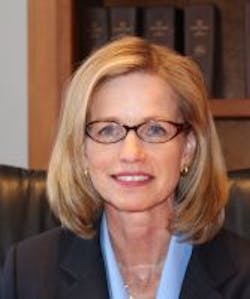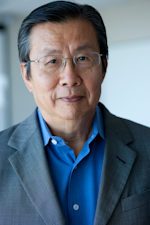
This is the fourth in a series of interviews with leaders of our professional societies. I interviewed Liz Rogan, CEO of The Optical Society (OSA), because this professional society is a vital part of our industry’s infrastructure. It enables us to keep up with technology advancements and also represents our overall interest in Washington.
Rogan joined OSA in 1992 and has been CEO of OSA and the OSA Foundation since 2002. Before that, she was with the Kennedy Center for the Performing Arts, worked for the Architect of the Capitol, and spent time on a senate campaign and with a political action committee. Prior to transitioning to the non-profit world, Rogan held corporate positions in public accounting and banking. She has a BA in Accounting from the University of Connecticut, is a CPA, and is an alumnus of an executive business program from the Wharton School at the University of Pennsylvania.
Milton Chang: How would you describe the mission of OSA to a layperson?
Liz Rogan: OSA supports the global ecosystem of optical and photonic science and technology through four areas of activity: meetings and networking, publishing and archiving, honoring achievement, and educating the public and advocating for policies that further this important field.
MC:It is interesting that you put meetings and networking as one activity.
LR: We facilitate conversations among the best researchers, engineers, and business leaders. Since 2011, for example, the OSA Incubator Meetings have helped identify emerging areas, examine technology problems, and consider how to turn technologies into products. These meetings bring together experts from varied backgrounds with shared interests to further professional collaboration.
MC: Say more about OSA’s publications.
LR: OSA produces 17 journals and transforms 8000+ manuscripts into high-quality, peer-reviewed content every year. We publish the largest collection of peer-reviewed optics and photonics content. OPN, our monthly member magazine, just won two awards for excellence.
MC: What else does OSA do in education?
LR: To foster the next generation of researchers and entrepreneurs, OSA now has 350 Student Chapters. The International OSA Network of Students (IONS) organizes regional and online meetings on professional development and networking, helping students find jobs and furthering their careers.
In a separate vein, we also support ScienceCounts, a new organization to market science’s role in everyday life to gain public support. OSA’s Rising Star Program identifies scientists who are natural storytellers and trains them to talk to the media. Research presented at CLEO 2014 attracted international media attention with nearly 600 stories and has a potential audience reach of 140 million.
MC: Tell us about OSA’s activities in Washington.
LR: We need to raise our industry’s profile with policy makers because optics is layered into various products, and companies are not highly visible. OSA is very effective inside and outside the Washington Beltway by involving our members with funding and regulatory agencies. I’ve testified frequently before Congress for federal investments in R&D funding for NIST and NSF. OSA, along with SPIE, APS, LIA, and the IEEE Photonics Society, are founding partners of the National Photonics Initiative (NPI) to connect experts from industry, academia, and government. It is making recommendations for funding and investment in key photonics-driven fields.
MC: What’s your take on the potential impact of the National Photonics Initiative?
LR: I feel the U.S. photonics industry needs to develop a culture of organizing, just as the semiconductor industry did to create SEMATECH during the 1980s. The NPI is focusing on bridging the gap between advanced research and production, which will expand U.S. leadership in photonics. Increasing federal research funding in optics and photonics will increase the innovative and creative technology applications available to industry.
MC: How big is OSA to do all that?
LR: OSA has 250 corporate members,18,500 individual members, and a staff of 150. We bring together 220,000 professionals from over 175 countries.
MC: What drew you to OSA—what excites you?
LR: I interviewed with Jarus Quinn, the executive director, and connected with him immediately. The people and the thrill that comes with scientific discovery excites me. It is so fortunate to know and enjoyable to work with members like Paul Forman, Tony Siegman, and Tingyi Li. When I first joined OSA, Forman explained Zygo’s work in retroreflectors that measure the distance between the earth and the moon. How cool is that?
MC: How does your finance background help you manage OSA?
LR: All CEOs can benefit from a solid financial background. I’m able to note early financial indicators and not panic through market fluctuations.
MC: How has our industry changed in your 12-year tenure and what would you have done differently?
LR: Our members/customers across the globe have more choices and better access via technology for self-directed products and programs. The science and engineering community is more unified. Fortunately, the optics/photonics community has always had incredible enthusiasm, innovation, and energy—the engine behind every OSA activity. None of the accomplishments of my tenure could have happened without OSA volunteer leadership and staff providing direction and support. In retrospect, OSA could have invested more in acting on the findings of the first U.S. National Academy study, Harnessing Light, in the late 1990s. It took a second study in 2012 to fully engage the community.
MC: So what is your vision for OSA going forward?
LR: OSA will continue to provide high-quality information and services and to encourage the best minds to enter this field. OSA will play a part to improve the visibility of the capability of the optics and photonics community to solve complex world challenges to attract more resources.
MC: What are your near-term focuses?
LR: Like a private company, OSA has to stay relevant to its customers with a viable business model, a rational strategy, capable staff, and financially sound operations. Changes in how we work and live require continual investment in the technical tools our customers use to access the information, data, and connections they need to grow professionally. The ever-emergent relevant content comes from our members and volunteers. Volunteerism is not universally appreciated, so we’ll continue to cultivate and support this valuable resource. In the very near term, we are planning the celebration of the OSA centennial in 2016 (!) and also support the International Year of Light in 2015.
MC: I would like to end this interview with a more practical question: Where are business and job opportunities?
LR: Telecommunications, health and medicine, energy, advanced manufacturing, and other consumer technologies will grow over the next 10 years. Times of great innovation create opportunities for educated and skilled workers who are willing to work in ways that may not be on their radar screen. We need to create opportunities for a wider circle of optics and photonics workers.

Milton Chang
MILTON CHANG of Incubic Management was president of Newport and New Focus. He is currently director of mBio Diagnostics and Aurrion; a trustee of Caltech; a member of the SEC Advisory Committee on Small and Emerging Companies; and serves on advisory boards and mentors entrepreneurs. Chang is a Fellow of IEEE, OSA, and LIA. Direct your business, management, and career questions to him at [email protected], and check out his book Toward Entrepreneurship at www.miltonchang.com.